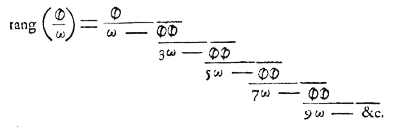Proof that π is irrational
In the 1760s, Johann Heinrich Lambert was the first to prove that the number π is irrational, meaning it cannot be expressed as a fraction
In 1882, Ferdinand von Lindemann proved that
Lambert's proof
In 1761, Lambert proved that
Then Lambert proved that if
Hermite's proof
Written in 1873, this proof uses the characterization of
Consider the sequences of real functions
Using induction we can prove that
and therefore we have:
So
which is equivalent to
Using the definition of the sequence and employing induction we can show that
where
Hermite also gave a closed expression for the function
He did not justify this assertion, but it can be proved easily. First of all, this assertion is equivalent to
Proceeding by induction, take
and, for the inductive step, consider any natural number
then, using integration by parts and Leibniz's rule, one gets
If
But this number is clearly greater than
Hermite did not present his proof as an end in itself but as an afterthought within his search for a proof of the transcendence of
Moreover, Hermite's proof is closer to Lambert's proof than it seems. In fact,
Cartwright's proof
Harold Jeffreys wrote that this proof was set as an example in an exam at Cambridge University in 1945 by Mary Cartwright, but that she had not traced its origin.[7] It still remains on the 4th problem sheet today for the Analysis IA course at Cambridge University.[8]
Consider the integrals
where
Two integrations by parts give the recurrence relation
If
then this becomes
Furthermore,
where
Take
The right side is an integer. But
Hence, for sufficiently large
that is, we could find an integer between
This proof is similar to Hermite's proof. Indeed,
However, it is clearly simpler. This is achieved by omitting the inductive definition of the functions
Niven's proof
This proof uses the characterization of
Suppose that
and, for each
Claim 1:
Proof:
Expanding
On the other hand,
Claim 2:
Proof: Since
The derivatives of the sine and cosine function are given by sin' = cos and cos' = −sin. Hence the product rule implies
By the fundamental theorem of calculus
Since
Conclusion: Since
which is smaller than
The above proof is a polished version, which is kept as simple as possible concerning the prerequisites, of an analysis of the formula
which is obtained by
Niven's proof is closer to Cartwright's (and therefore Hermite's) proof than it appears at first sight.[6] In fact,
Therefore, the substitution
In particular,
Another connection between the proofs lies in the fact that Hermite already mentions[3] that if
then
from which it follows that
Bourbaki's proof
Bourbaki's proof is outlined as an exercise in his calculus treatise.[10] For each natural number b and each non-negative integer
Since
and therefore
On the other hand, repeated integration by parts allows us to deduce that, if
then:
This last integral is
This proof is quite close to Niven's proof, the main difference between them being the way of proving that the numbers
Laczkovich's proof
Miklós Laczkovich's proof is a simplification of Lambert's original proof.[11] He considers the functions
These functions are clearly defined for any real number
Claim 1: The following recurrence relation holds for any real number
Proof: This can be proved by comparing the coefficients of the powers of
Claim 2: For each real number
Proof: In fact, the sequence
Claim 3: If
Proof: Otherwise, there would be a number
Then
On the other hand, it follows from claim 1 that
which is a linear combination of
Since
On the other hand, since
another consequence of Claim 3 is that, if
Laczkovich's proof is really about the hypergeometric function. In fact,
Laczkovich's result can also be expressed in Bessel functions of the first kind
See also
- Proof that e is irrational
- Proof that π is transcendental
References
- ↑ Lindemann, Ferdinand von (2004), "Ueber die Zahl π", in Berggren, Lennart; Borwein, Jonathan M.; Borwein, Peter B., Pi, a source book (3rd ed.), New York: Springer-Verlag, pp. 194–225, ISBN 0-387-20571-3.
- ↑ Lambert, Johann Heinrich (2004), "Mémoire sur quelques propriétés remarquables des quantités transcendantes circulaires et logarithmiques", in Berggren, Lennart; Borwein, Jonathan M.; Borwein, Peter B., Pi, a source book (3rd ed.), New York: Springer-Verlag, pp. 129–140, ISBN 0-387-20571-3.
- ↑ Jump up to: 3.0 3.1 Hermite, Charles (1873). "Extrait d'une lettre de Monsieur Ch. Hermite à Monsieur Paul Gordan" (in fr). Journal für die reine und angewandte Mathematik 76: 303–311. http://www.digizeitschriften.de/main/dms/img/?PPN=GDZPPN002155435.
- ↑ Hermite, Charles (1873). "Extrait d'une lettre de Mr. Ch. Hermite à Mr. Carl Borchardt" (in fr). Journal für die reine und angewandte Mathematik 76: 342–344. http://www.digizeitschriften.de/main/dms/img/?PPN=GDZPPN00215546X.
- ↑ Hermite, Charles (1912). "Sur la fonction exponentielle". in Picard, Émile (in fr). Œuvres de Charles Hermite. III. Gauthier-Villars. pp. 150–181. http://quod.lib.umich.edu/cgi/t/text/pageviewer-idx?c=umhistmath;cc=umhistmath;rgn=full%20text;idno=AAS7821.0003.001;didno=AAS7821.0003.001;view=pdf;seq=00000161.
- ↑ Jump up to: 6.0 6.1 Zhou, Li (2011). "Irrationality proofs à la Hermite". The Mathematical Gazette 95 (534): 407–413. doi:10.1017/S0025557200003491.
- ↑ Jeffreys, Harold (1973), Scientific Inference (3rd ed.), Cambridge University Press, p. 268, ISBN 0-521-08446-6, https://archive.org/details/scientificinfere0000jeff/page/268
- ↑ "Department of Pure Mathematics and Mathematical Statistics". http://www.dpmms.cam.ac.uk/study/IA/AnalysisI/.
- ↑ Niven, Ivan (1947), "A simple proof that π is irrational", Bulletin of the American Mathematical Society 53 (6): 509, doi:10.1090/s0002-9904-1947-08821-2, https://www.ams.org/bull/1947-53-06/S0002-9904-1947-08821-2/S0002-9904-1947-08821-2.pdf
- ↑ Bourbaki, Nicolas (1949) (in fr), Fonctions d'une variable réelle, chap. I–II–III, Actualités Scientifiques et Industrielles, 1074, Hermann, pp. 137–138
- ↑ Laczkovich, Miklós (1997), "On Lambert's proof of the irrationality of π", American Mathematical Monthly 104 (5): 439–443, doi:10.2307/2974737
- ↑ Gauss, Carl Friedrich (1811–1813), "Disquisitiones generales circa seriem infinitam" (in la), Commentationes Societatis Regiae Scientiarum Gottingensis Recentiores 2
 |


